Flushing Meadows Corona Park history development fmcp

Flushing Meadows Corona Park History & Development
Exclusive Coverage Of Flushing Meadows Corona Park
Special Section Dedicated To Our Coverage Of Flushing Meadows Corona Park. Stories about the history of Flushing Meadows Corona Park and stories of developers trying to develop it and privatize it.
Yankees Join Sheik For NYC Soccer
Sheik & Yankees Team Up For NYC Soccer Team
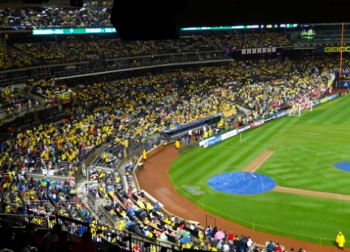 May 21, 2013 / Queens Buzz. The Yankees joined the Sheik to acquire an MLS NYC soccer team, thus adding an influential local owner to the roster of MLS stadium supporters. The Sheik's Manchester Club would own the majority shares.
May 21, 2013 / Queens Buzz. The Yankees joined the Sheik to acquire an MLS NYC soccer team, thus adding an influential local owner to the roster of MLS stadium supporters. The Sheik's Manchester Club would own the majority shares.
MLS is seeking to locate a 13 acre stadium in the middle of Flushing Meadows Corona Park. If professional soccer continues growing in popularity, MLS could quickly outgrow the proposed 25,000 seat stadium, and need to expand. Plans are to begin MLS soccer play in NYC in 2015.
Click here for related story on the history / issues associated with building stadiums in Flushing Meadows Corona Park. The photo above was taken at an out-of-league soccer game played at CitiField in 2012.
Flushing Meadows Corona Park Update
USTA Proposal Moves Ahead / QMA Hosts Visioning
April 22, 2013 / Queens Neighborhoods / Queens Buzz. In early April, there was a meeting held to vote on whether to give up 0.68 of an acre of Flushing Meadows Corona Park to the USTA to allow them to proceed with their expansion plans.
 Most Queens elected officials have now taken public stands on the issue, as it is a matter of some concern with Queens voters. Nonetheless, in spite of their public statements, only a few City Councilmembers made the effort to show up to vote on it. According to a story in the Queens Chronicle, the only Queens City Councilmembers who showed up to vote on the proposed USTA Expansion Plan were: Daniel Dromm of Jackson Heights, Peter Koo of Flushing, Donovan Richards of Rosedale and Ruben Wills of Jamaica. As we reported earlier this year, the Queens Community Boards representing the neighborhoods that had surrounded the park, had split votes on the matter with three Community Boards voting for it, and three voting against it.
Most Queens elected officials have now taken public stands on the issue, as it is a matter of some concern with Queens voters. Nonetheless, in spite of their public statements, only a few City Councilmembers made the effort to show up to vote on it. According to a story in the Queens Chronicle, the only Queens City Councilmembers who showed up to vote on the proposed USTA Expansion Plan were: Daniel Dromm of Jackson Heights, Peter Koo of Flushing, Donovan Richards of Rosedale and Ruben Wills of Jamaica. As we reported earlier this year, the Queens Community Boards representing the neighborhoods that had surrounded the park, had split votes on the matter with three Community Boards voting for it, and three voting against it.
Outgoing [term limited] Borough President, Helen Marshall, was the Queens elected official who made the decision for the borough, supporting the USTA expansion. According to the Queens Chronicle story, she was quoted as saying that she insists the alienated parkland be replaced. Her statement is at odds with the Bloomberg Administration position taken earlier this year, where they said that the Flushing Meadows Corona parkland doesn't have to be replaced by the USTA, even though NY State law requires it [apparently there is some wiggle room given to the municipal executive].
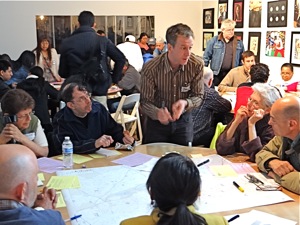 The Queens Museum of Art hosted a visioning session to see what the general public would like to see come of the park. Julissa Ferreras, City Councilmember representing Corona was on hand to speak, as well as several students from the Pratt Institute of Brooklyn which has a highly respected program for sustainable urban development. Participants included over 100 local residents as well as representatives of the USTA.
The Queens Museum of Art hosted a visioning session to see what the general public would like to see come of the park. Julissa Ferreras, City Councilmember representing Corona was on hand to speak, as well as several students from the Pratt Institute of Brooklyn which has a highly respected program for sustainable urban development. Participants included over 100 local residents as well as representatives of the USTA.
Whose park is it? And whose park will it be? Stay tuned - as you are likely to decide the matter by whomever you vote for in this upcoming election. Click here to read an early account of Flushing Meadows Corona Park history and click here to read our second account about early Flushing Meadows Corona Park development with relevant analogies to some of the proposed developments working their way through the governing process today.
CB Votes Split On USTA Expansion Plan
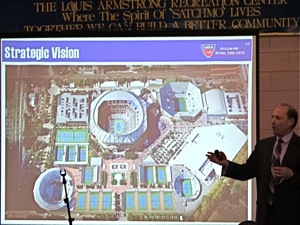 March 14, 2013 / Flushing Corona / Issues Facing Queens / Queens Buzz. The USTA has asked the city of New York to give it .68 of an acre of Flushing Meadows Corona Park so that it can proceed with an expansion plan. The expansion plan is estimated to increase the sports complex capacity for the U.S. Open by about a third, while increasing the USTA footprint in the park by .68 of an acre. The USTA informed the audience attending the Community Board 3 meeting that this will result in more jobs in Queens. They also talked about the positive estimated annual $784 million economic impact that the USTA has had on NYC - according to a study done by a private consulting firm named AKRF, Inc.
March 14, 2013 / Flushing Corona / Issues Facing Queens / Queens Buzz. The USTA has asked the city of New York to give it .68 of an acre of Flushing Meadows Corona Park so that it can proceed with an expansion plan. The expansion plan is estimated to increase the sports complex capacity for the U.S. Open by about a third, while increasing the USTA footprint in the park by .68 of an acre. The USTA informed the audience attending the Community Board 3 meeting that this will result in more jobs in Queens. They also talked about the positive estimated annual $784 million economic impact that the USTA has had on NYC - according to a study done by a private consulting firm named AKRF, Inc.
The detractors informed the audience that this is the first step in a much larger effort toward a massive privatization of Flushing Meadows Corona Park by several large, well-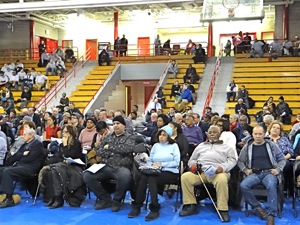 funded corporate interests. The opponents talked about three other proposals which were not a part of the USTA plan. These other proposals to develop private interests on public parkland include the development of a shopping mall by a private investment group in tandem with the owners of CitiField; 2) a condominium / hotel complex done by another group of private investors; and 3) a 13 acre soccer stadium by Major League Soccer, which is also a privately held corporation.
funded corporate interests. The opponents talked about three other proposals which were not a part of the USTA plan. These other proposals to develop private interests on public parkland include the development of a shopping mall by a private investment group in tandem with the owners of CitiField; 2) a condominium / hotel complex done by another group of private investors; and 3) a 13 acre soccer stadium by Major League Soccer, which is also a privately held corporation.
Community Board Tally & Boro Prez Candidates Positions
In the end Community Board 3 voted against the expansion plan, citing among other things, promises not kept when the USTA asked to expand its footpint in 1993. All six Community Boards have now voted on the USTA Expansion proposal, with three voting for it and three voting against it. We'll post a far more complete report on this Community Board Meeting at a later date.
While I was attending the Community Board 3 Meeting in Corona, all six Queens Borough Presidential candidates were attending a forum about the issues facing Queens at the Greater Astoria Historical Society in Astoria. The issue of turning over public parkland to private interests came up during the forum. To date only City Councilmember Tony Avella has come out against giving up public parkland to private interests. NY Senator Jose Peralta is the only other candidate to take a stance on the issue, but only on one of the proposed developments, namely the erection of the MLS Soccer Stadium on 13 acres of FMC Parkland [which he conditionally supports if MLS fulfills all of their promises]. All four other candidates have taken a wait-and-see stance on the issue.
Click here to read our past reports related to the proposed development plans for Flushing Meadows Corona Park. The first report provides an early history of Flushing Meadows Corona Park I and the second report provided an intermediate history of Flushing Meadows Corona Park II which included a number of relevant historic lessons related to sports complex developments in FMCP as well as NYC.
$element(bwcore,article_picker,971-974-774-141,Y,N,page_title_home,N)$
Flushing / Corona Related Info
Click here to go to the Art Exhibits, Galleries & Museums section of this site.
Click these links for promotions by advertisers in Queens.
Click this link to go to the Flushing Neighborhood.
Flushing Events / Things To Do In Flushing
Flushing Real Estate & Business
Site Search Tips. 1) For best results, when typing in more than one word, use quotation marks - eg "Astoria Park". 2) Also try either singular or plural words when searching for a specific item such as "gym" or "gyms".
$element(bwcore,insert_search,N)$
Click this link to search for something in our Queens Business Directory.
$element(adman,groupads,Sectional Ad)$
Click the log in link below to create an ID and post an opinion.
Or send this story to a friend by filling in the appropriate box below.
1939 Worlds Fair - NYC World's Fair 1939 - 1940
Battle for the Heart of a Park …
... and the Soul of a Borough
The NYC World's Fair: 1939 - 1940 in Flushing Queens
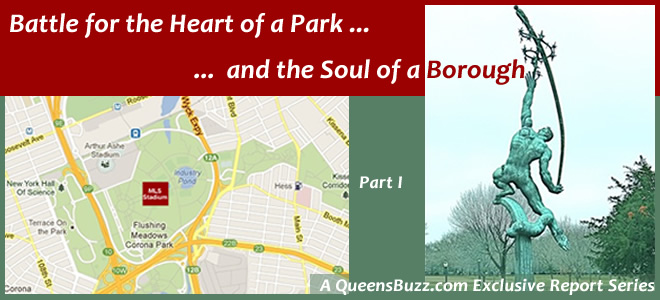
PART ONE - Out of the Ashes Rises the Phoenix
January 12, 2013 / Queens Neighborhoods / Queens Issues / Queens Buzz. Over the past six months we’ve been watching with interest as events have been unfolding regarding the building of a 25,000 seat soccer stadium right in the heart of Flushing Meadows Corona Park. There are also a number of other proposals working their way through the political process / local government, which calls for the cessation of public lands to build private enterprises on various sections of Flushing Meadows Corona Park.
 Currently four separate proposals are in process for planned developments in Flushing Meadow Corona Park. They include: 1) a chain store shopping mall / complex in the southwest corner of the Citifield parking lot [pink], 2) a housing / condominium / hotel complex on the lands the city acquired in its use of eminent domain to develop Willets Point [blue], 3) the expansion of the USTA facilities in the northwest section of the USTA franchise in the park [orange] and 4) the erection of a thirteen plus acre stadium / sports complex in the middle of Flushing Meadows Corona Park [yellowish green].
Currently four separate proposals are in process for planned developments in Flushing Meadow Corona Park. They include: 1) a chain store shopping mall / complex in the southwest corner of the Citifield parking lot [pink], 2) a housing / condominium / hotel complex on the lands the city acquired in its use of eminent domain to develop Willets Point [blue], 3) the expansion of the USTA facilities in the northwest section of the USTA franchise in the park [orange] and 4) the erection of a thirteen plus acre stadium / sports complex in the middle of Flushing Meadows Corona Park [yellowish green].
The graphic above was provided by one of the community groups opposed to the Flushing Meadow Corona Park developments. It's worth noting that most of the colored areas already have pavement or structures covering the land. The exception is that of the proposed Stadium & Concert venue [yellowish green], which would be a completely new development, replacing water vessels which were created for the Worlds Fair. See the map in the header of this series [top of page] where the dark red square represents the approximate acreage and location of the proposed stadium / concert venue.
Queens Buzz has put together a series of reports, which we will run in the coming days about the proposed developments in Flushing Meadow Corona Park. This report starts with a bit of the history of the park, which began around the turn of the last century when Flushing Meadows Corona Park was just an ashpile. The focus of this report is the 1939 NYC World's Fair which was held in Flushing Meadow Park as it was then called. Story & photos by Michael Wood.
Battle for the Heart of a Park …
... and the Soul of a Borough
The NYC World's Fair: 1939 - 1940 in Flushing Queens
PART ONE - Out of the Ashes Rises the Phoenix
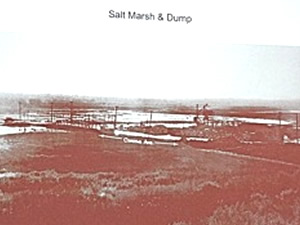 January 12, 2013 / Queens Neighborhoods / Queens Issues / Queens Buzz. Continued. Our journey begins more than 100 years ago, when the land south of Flushing Bay that ran along the Flushing River was just a salt marsh. The photo to your left was taken from a slide presented by Matthew Malina at the Queens Museum of Art in January of 2013.
January 12, 2013 / Queens Neighborhoods / Queens Issues / Queens Buzz. Continued. Our journey begins more than 100 years ago, when the land south of Flushing Bay that ran along the Flushing River was just a salt marsh. The photo to your left was taken from a slide presented by Matthew Malina at the Queens Museum of Art in January of 2013.
Flushing / Corona Salt Marsh - 1900
Our story begins about 1900, as New York City was emerging as one of the great cities of the world. At that time, Flushing Meadows was a salt marsh, fed by the saline waters of Flushing Bay, which lies between the East River to the west and the Long Island Sound to the northeast. The Flushing River ran south from the bay into Queens. A dump was built nearby, just off Corona Avenue and called the Corona dump.
Corona Ash Dump & the Brooklyn Ash Company
The fast growing populations of Manhattan and Brooklyn were heated by wood and coal, and the ashes would be carted away by the Brooklyn Ash Company to Barren Island. In 1909 the Brooklyn Ash Company, owned by John McCarthy, started using Flushing Meadows as its ash dump.
 Flushing Meadow Corona Park in Great Gatsby Novel 1925 & Silent Film 1926
Flushing Meadow Corona Park in Great Gatsby Novel 1925 & Silent Film 1926
Sixteen years later, F. Scott Fitzgerald would characterize the Corona Dump as a “valley of ashes, a fantastic farm, where ashes grow like wheat” in his novel the Great Gatsby. At the time of the publication of the Gatsby book in 1925, the ashes were said to be some 90 feet high. The original cover of the novel is shown in the graphic to your right.
The Great Gatsby & American Optimism
The Great Gatsby was a romance novel about an optimistic boy who had fallen in love with a rich girl just before he went off to fight in WWI. They had promised each other to marry when he returned from the war, but she married someone else in her class before he returned. He became fabulously wealthy [as a bootlegger], bought a home on the northern coast of Long Island across the Long Island Sound from the Connecticut home of the woman he loved. He’s constantly optimistic, pursuing the American dream.
Robert Moses / NYC Purchase Corona Ash Dump
 In 1934 NYC Parks Commissioner Robert Moses had NYC acquire the Corona Ash Dump. Moses made the purchase with the 1939 – 1940 Worlds Fair in mind. Moses’ vision went well beyond the Worlds Fair, and he used 1939 – 1940 Worlds Fair funds to clear, level and make usable, the 1,216 acres of the Corona Ash Dump, in preparation for the fair.
In 1934 NYC Parks Commissioner Robert Moses had NYC acquire the Corona Ash Dump. Moses made the purchase with the 1939 – 1940 Worlds Fair in mind. Moses’ vision went well beyond the Worlds Fair, and he used 1939 – 1940 Worlds Fair funds to clear, level and make usable, the 1,216 acres of the Corona Ash Dump, in preparation for the fair.
The City of New York, lead by Robert Moses and the World’s Fair executives, transformed the valley of ashes into a sort of utopian village. From 1936 - 1937 they moved between 7 and 8 million cubic yards of material to create America's largest landfill site. During this time they also bury the Flushing River, running it underground via tunnels which still function today. In its place they create two man made lakes: Meadow Lake and Willow Lake which are used as scenic areas during the World’s Fair.
The photo to your right was taken of Flushing Meadow Park, formerly the Corona Ash Dump, looking southwest in the 1930's [Queens Museum of Art exhibit 2011]. The Flushing River was taken underground and replaced by Meadow and Willow lakes.
World’s Fairs in the 1930’s – City Museum of New York
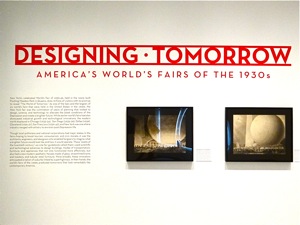 It’s important to note that during the 1930’s there were quite a number of World’s Fairs, throughout the U.S. in Chicago [1933-1934], San Diego [1935-1936], Cleveland [1936-1937], Dallas [1936-1937], San Francisco [1939], Miami [1937] in addition to the 1939 – 1940 Worlds Fair in NYC at Flushing Meadow Park. The reason there were a lot of fairs then and not now is that theme parks like Disneyland, Disney World, Busch Gardens, Great America, Universal Studios and others just didn’t exist.
It’s important to note that during the 1930’s there were quite a number of World’s Fairs, throughout the U.S. in Chicago [1933-1934], San Diego [1935-1936], Cleveland [1936-1937], Dallas [1936-1937], San Francisco [1939], Miami [1937] in addition to the 1939 – 1940 Worlds Fair in NYC at Flushing Meadow Park. The reason there were a lot of fairs then and not now is that theme parks like Disneyland, Disney World, Busch Gardens, Great America, Universal Studios and others just didn’t exist.
The City Museum of New York currently has an exhibit on the World’s Fairs of the 1930’s on display now through March 31, 2013. We thank them for their contributions of information and photos for this story [see City Museum of New York exhibit entrance in photo to left].
1939 – 1940 Worlds Fair Organizers & Flushing Meadow Park
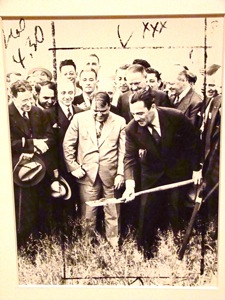 New York City was still suffering from the economic impact of the Great Depression. The 1939 – 1940 Worlds Fair was part of the city’s plan to wrest itself out of the economic doldrums. The idea was the brainchild of the former police chief, Grover Whalen, who became president and chief promoter of the 1939 – 1940 Worlds Fair.
New York City was still suffering from the economic impact of the Great Depression. The 1939 – 1940 Worlds Fair was part of the city’s plan to wrest itself out of the economic doldrums. The idea was the brainchild of the former police chief, Grover Whalen, who became president and chief promoter of the 1939 – 1940 Worlds Fair.
Working in tandem with Mayor LaGuardia, NYC Parks Commissioner Robert Moses and an Executive Committee; the 1939 – 1940 World’s Fair organizers set about to create the greatest Worlds Fair ever. Stephen Voorhees was the chief Architect, Harvey Gibson handled finances and Howard Flanigan, VP, handled labor. And within a couple of years the Corona Ash Pile was renamed and transformed into Flushing Meadow Park.
In the photo to your right, inside the crop lines are NYC Parks Commissioner Robert Moses, NYC Mayor Fiorello LaGuardia and World's Fair president Grover Whalen [Queens Museum of Art exhibit 2011].
1939 – 1940 Worlds Fair Theme – A Utopian World of Tomorrow
 The Worlds Fair theme was about the World of Tomorrow. The whole fair was dedicated to heralding in the new ‘scientific era’ when the home would be automated with appliances to do the work for you, and American cities would be modern technological marvels, full of cars, bridges, tunnels, traffic lights and super highways taking individual mobility to a whole new level. World’s Fair attendees would get a glimpse into the utopian future that awaited them.
The Worlds Fair theme was about the World of Tomorrow. The whole fair was dedicated to heralding in the new ‘scientific era’ when the home would be automated with appliances to do the work for you, and American cities would be modern technological marvels, full of cars, bridges, tunnels, traffic lights and super highways taking individual mobility to a whole new level. World’s Fair attendees would get a glimpse into the utopian future that awaited them.
The photo to your right shows a pamphlet published by Con Edison for the 1939 World's Fair [Queens Museum of Art exhibit 2011]. Robert Moses, the NYC City Planner, used the 1939 World's Fair to build more bridges, roads and make subway line enhancements. In 1933 the first section of the Grand Central Parkway to the Nassau County line was completed. In 1936 the Interborough [now Jackie Robinson Parkway] to the Triborough Bridge was completed. From 1937 - 1939 the Whitestone Bronx Bridge was completed. And through the end of the decade enhancement work continued on the E, F, R, M and #7 line subway lines.
1939 – 1940 World’s Fair at Flushing Meadow Park - Statistics
The 1939 – 1940 World’s cost $157 million to produce, included 200 buildings, was participated in by 58 nations, 33 states and 1354 exhibitors. The 1939 World’s Fair was attended by 26 million people and the 1940 World’s Fair was attended by about 14 million people. According to reports, the 1939 - 1940 NYC World's Fair grossed about $46 million and cost about three times that amount.
First Broadcast To Public Via Television – 1939 World’s Fair
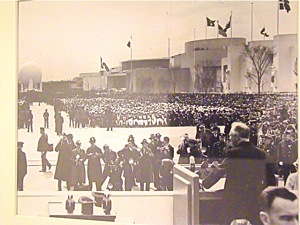 On April 30, 1939, the 32nd president of the United States, Franklin Delano Roosevelt [FDR], gave the opening speech at the 1939 World’s Fair which was broadcast via television to the public. It was received on televisions at the RCA building [RCA was NBC’s parent company at the time] on the fairgrounds as well on several hundred television sets through which hundreds of people saw the speech broadcast. It was the first broadcast made via television to the public [the first television broadcast was made by inventor Philo T. Farnsworth in 1928 in front of the press].
On April 30, 1939, the 32nd president of the United States, Franklin Delano Roosevelt [FDR], gave the opening speech at the 1939 World’s Fair which was broadcast via television to the public. It was received on televisions at the RCA building [RCA was NBC’s parent company at the time] on the fairgrounds as well on several hundred television sets through which hundreds of people saw the speech broadcast. It was the first broadcast made via television to the public [the first television broadcast was made by inventor Philo T. Farnsworth in 1928 in front of the press].
In the photo to your right, President Roosevelt is making the first public television broadcast [Queens Museum of Art exhibit 2011].
Roosevelt Speech at 1939 World’s Fair
Roosevelt kept his remarks short. He commemorated the 150th anniversary of George Washington being sworn in as the first U.S. president in 1789. He congratulated the nation on making few changes to the basic structure of government since its inception, while the nation grew remarkably from 13 states to 48 states and from under 4 million people to over 130 million people. And while optimistic about the future, he expressed concern for the events unfolding in Europe [Hitler had taken over Czechoslovakia a month earlier]. Albert Einstein also appeared and gave a speech about cosmic rays.
1939 – 1940 Worlds Fair NYC - Zones & Categories
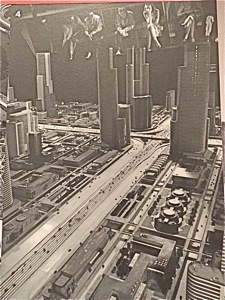 The fair was organized into seven zones including the Amusement zone, Transportation zone [future highways, trains & planes], Government zone where nations showed off local cultures, Food zone [spirits, tobacco, meat and bakery], Communications and Business Systems zone [ATT & IBM - robot], Production & Distribution [glass, metals, consumer products] zone, & community Interests [education, art, shelter, recreation & religion].
The fair was organized into seven zones including the Amusement zone, Transportation zone [future highways, trains & planes], Government zone where nations showed off local cultures, Food zone [spirits, tobacco, meat and bakery], Communications and Business Systems zone [ATT & IBM - robot], Production & Distribution [glass, metals, consumer products] zone, & community Interests [education, art, shelter, recreation & religion].
The photo to your right shows visitors perched above the Futurama exhibit depicting America in the 1960's [Museum of the City of New York - photo by Margaret Bourke-White / courtesy of the estate of Edith Lutyens Bel Geddes at University of Texas at Austin].
1939 – 1940 NYC Worlds Fair - Futurama, The Ford Family & Transportation
To that end General Motors built Futurama, a ride that took passengers around a football sized exhibit showing cities connected by freeways and bridges which they said would be built by 1960. The set was created by Norman Del Geddes, a Texas designer, who’s miniature model at the World’s Fair foreshadowed the federal 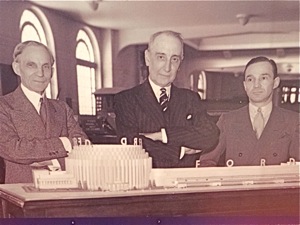 interstate highway system built in the 1950’s during the Eisenhower years. The floor model had about a half million homes and tens of thousands of autos were included in the exhibit.
interstate highway system built in the 1950’s during the Eisenhower years. The floor model had about a half million homes and tens of thousands of autos were included in the exhibit.
Henry Ford built a racetrack atop the Ford exhibit building and reportedly had drivers circling the race track 24 hours a day. There was an airplane exhibit, showing the latest marvel in transportation, as the New York Municipal Airport [LaGuardia Airport] had just opened in time for the 1939 World’s Fair. And there was a large train exhibit showing trains past and present, as trains were still one of the primary means of passenger transportation of that day. The photo to your left shows Henry Ford, Edsel Ford and Rufus Dawes at the 1939 - 1940 World's Fair in NYC [photo taken from the Museum of the City of New York exhibit - Collections of the Henry Ford].
World of Tomorrow 1939 – Business Systems & Communications
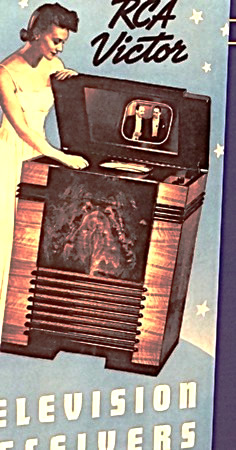 The Business Systems and Communications section of the 1939 – 1940 World’s Fair was all about technology for the home and workplace. As mentioned previously, the first television broadcast to the public was made by FDR at the 1939 World’s Fair using RCA / NBC equipment [the first television broadcast was made by Philo T. Farnsworth in 1928]. The opening ceremony was the first television broadcast by a television broadcasting company [NBC], and was receivable within a 50 mile radius. At the time of the fair only 200 TV sets received the broadcast, as newspapers were the dominant medium, and radio was the dominant [and only] broadcast medium.
The Business Systems and Communications section of the 1939 – 1940 World’s Fair was all about technology for the home and workplace. As mentioned previously, the first television broadcast to the public was made by FDR at the 1939 World’s Fair using RCA / NBC equipment [the first television broadcast was made by Philo T. Farnsworth in 1928]. The opening ceremony was the first television broadcast by a television broadcasting company [NBC], and was receivable within a 50 mile radius. At the time of the fair only 200 TV sets received the broadcast, as newspapers were the dominant medium, and radio was the dominant [and only] broadcast medium.
In the photo to your left you can see an advertisement for the latest and greatest consumer electronic gadget of the day - a television receiver built to look like furniture [Museum of the City of New York - Edward J Orth Memorial Archives - National Museum of American History - Smithsonian Institute].
IBM was there and exhibited nascent computer technologies. At the time, even the best computers money could buy, didn’t have the processing power of a video game, smart phone or ipad of today.
1939 NYC World’s Fair – Production & Distribution Zone
Westinghouse Electric built a robot, which they named Elektro. It took them two years to  build [1937 & 1938] and they premiered Elektro at the 1939 World’s Fair. Elektro, a seven foot tall, 265 pound humanoid-like figure, would respond to basic voice commands. Elektro could talk with a vocabulary of 700 words, move his head and arms, smoke a cigarette and count. He was capable of doing a few other things, like cracking a joke or two. Elektro is shown in the photo to your right and his head is on exhibit at the Mansfield Memorial Museum in Ohio [Museum of the City of New York - an exhibit film entitled The Middleton Family at the New York World's Fair].
build [1937 & 1938] and they premiered Elektro at the 1939 World’s Fair. Elektro, a seven foot tall, 265 pound humanoid-like figure, would respond to basic voice commands. Elektro could talk with a vocabulary of 700 words, move his head and arms, smoke a cigarette and count. He was capable of doing a few other things, like cracking a joke or two. Elektro is shown in the photo to your right and his head is on exhibit at the Mansfield Memorial Museum in Ohio [Museum of the City of New York - an exhibit film entitled The Middleton Family at the New York World's Fair].
Westinghouse also put together a time capsule, containing mundane things of the age, that was buried and not to be opened for 5,000 years.
Electricity was said to be one of the primary features of the 1939 World’s Fair. Electricity 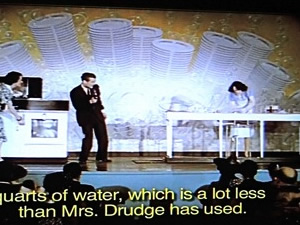 was first transmitted into the home in New York City in the late 1870’s, in Chicago in the 1880’s, and most large cities by 1920’s. But it wasn’t until the New Deal and Public Works programs of the 1930’s that small towns were receiving electricity too.
was first transmitted into the home in New York City in the late 1870’s, in Chicago in the 1880’s, and most large cities by 1920’s. But it wasn’t until the New Deal and Public Works programs of the 1930’s that small towns were receiving electricity too.
At first electricity was used primarily for lighting, but then for heating, cooking, washing, communications and so forth. General Electric premiered the first fluorescent light at the fair, providing high quality lighting at low cost. And Westinghouse conducted a dishwashing contest between a woman called Mrs. Drudge and a dishwashing machine run by Mrs. Modern [Museum of the City of New York - from an exhibit film entitled The Middleton Family at the New York World's Fair at left]. Guess who won?
World’s Fair Zones – Amusements, Food & Community Zones
The Amusements zone had a number of rides and I believe the zone was located near the twin lakes of Flushing Meadow Corona Park. The Food category showed how food was processed and packaged, a trend that seems to be reversing itself today. And community interests of recreation, education, art, religion and shelter] appears to be a zone that received far less attention in its day.
Government Zones at the 1939 – 1940 NYC World’s Fair
According to the literature there were 58 – 60 countries that participated in the 1939 – 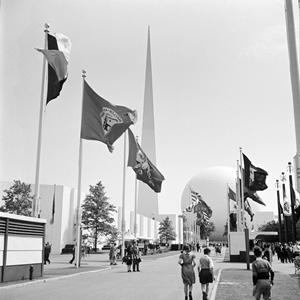 1940 NYC World’s Fair. The backdrop to this event is that Hitler had annexed Austria in March of 1938. In March 1939, just before the World’s Fair opened, Germany annexed Czechoslovakia. In August of 1939 Germany and the Soviet Union signed a non-aggression pact, and agreed to spheres of influence in Eastern Europe. Early in September 1939 Hitler invaded Poland, which was followed by England and France declaring war. The Soviets invade the Baltic states, and then Finland in November 1939. The Japanese invade China before the end of 1939.
1940 NYC World’s Fair. The backdrop to this event is that Hitler had annexed Austria in March of 1938. In March 1939, just before the World’s Fair opened, Germany annexed Czechoslovakia. In August of 1939 Germany and the Soviet Union signed a non-aggression pact, and agreed to spheres of influence in Eastern Europe. Early in September 1939 Hitler invaded Poland, which was followed by England and France declaring war. The Soviets invade the Baltic states, and then Finland in November 1939. The Japanese invade China before the end of 1939.
In 1940 the war continues, sweeping in the Benelux nations and the Scandinavian countries in the winter / spring of 1940. By June 1940 the Italians have allied themselves with the Nazis, Paris has fallen and France is partitioned. The Battle of Britain begins in July 1940. All hell has pretty much broken loose – except in fortress America. The 1939 – 1940 World’s Fair continues, while the rest of the world is engaged in war. The photo above was on exhibit at the Queens Museum of Art in Winter / Spring 2011. The photo above right shows Children walking down Constitution Mall 1939 and the flags of some of the 58 countries that participated in the 1939 World's Fair [Museum of the City of New York - Wurts Bros Collection].
Bomb at 1940 Worlds Fair – Two Policemen Die
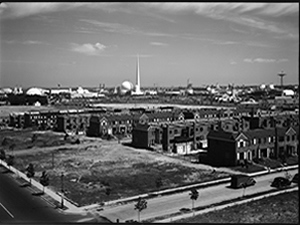 But little things spill over into the fair. The Czechoslovakian exhibit is the last remnant of an independent Czechoslovakia before the fair even begins in 1939. By the end of the fair, you can read the sequence of events above, to see that the Czechs were soon joined by many other exhibiting nations.
But little things spill over into the fair. The Czechoslovakian exhibit is the last remnant of an independent Czechoslovakia before the fair even begins in 1939. By the end of the fair, you can read the sequence of events above, to see that the Czechs were soon joined by many other exhibiting nations.
On July 4th 1940 two police officers killed while investigating a time bomb left at the British Pavilion. A bomb scare had been called in a couple of days earlier, but the bomb was found on July 4th by an electrician. The two police officers died while trying to defuse the ticking device which was found in a satchel. The perpetrators were never found. The photo above is looking north towards the 1939 - 1940 World's Fair site, 1939 [Museum of the City of New York - Wurts Bros. Collection].
Queens Museum of Art – Once Home of the U.N. General Assembly
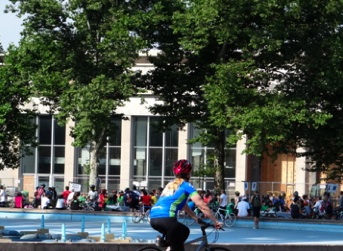 The building that is today occupied by the Queens Museum of Art was originally the New York City Building, which was NYC’s official Pavilion during the 1939 – 1940 Worlds Fair. It is one of the three remaining buildings from that fair. And from 1948 – 1952 served as the United Nations General Assembly Building. The facade of the Queens Museum of Art is shown in the photo to your left, as cyclists gathered prior to the Tour de Queens Bicycle Ride.
The building that is today occupied by the Queens Museum of Art was originally the New York City Building, which was NYC’s official Pavilion during the 1939 – 1940 Worlds Fair. It is one of the three remaining buildings from that fair. And from 1948 – 1952 served as the United Nations General Assembly Building. The facade of the Queens Museum of Art is shown in the photo to your left, as cyclists gathered prior to the Tour de Queens Bicycle Ride.
In some senses the Queens Museum of Art has been the steward of the history of Flushing Meadows Corona Park. In 2011 the Queens Museum hosted an exhibit about the 1939 – 1940 Worlds Fair. Fortunately for us [and you] we attended the exhibit and are re-presenting some of what was shown in the exhibit.
Flushing Meadow Boathouse
 The Flushing Meadows Boathouse was renovated 2008 – 2011. It is the second of the three surviving buildings from the 1939 – 1940 Worlds Fair. The third one, according to the Parks Department, is the Queens Garage, which is still used for Parks Department operations.
The Flushing Meadows Boathouse was renovated 2008 – 2011. It is the second of the three surviving buildings from the 1939 – 1940 Worlds Fair. The third one, according to the Parks Department, is the Queens Garage, which is still used for Parks Department operations.
In the photo to your left is the Flushing Meadow Boathouse while it was being renovated in 2010. The Flushing Meadow Boathouse is on Meadow Lake in Flushing Meadow Corona Park and the photo was taken during the Hong Kong Dragon Boat Races.
War Breaks out / Bonds go Bad
There was plenty of optimism going into the 1939 – 1940 World’s Fair, like the optimism of Jay Gatsby in the book about him. An ash pile was transformed into a utopian village. Science and technology promised to make our lives  better. The World of Tomorrow seemed to provide limitless opportunity.
better. The World of Tomorrow seemed to provide limitless opportunity.
But like the book, the story of the 1939 – 1940 World’s Fair didn’t end happily. Many nations had to pull out of the fair early as their countries had become immersed in war. Attendance, while setting records, failed to provide the revenue needed to cover the costs [one estimate put gross ticket receipts at $46 million versus a total cost of about $100 million more than that]. It seems the bondholders of the 1939 – 1940 World’s Fair lost their shirts; and Harvey Gibson, the Finance executive, was left scrambling trying to recoup what he could in selling off the exhibits and even, reportedly, trying to sell Flushing Meadow Park to the U.S. government as a military installation.
Thus out of the ashes immortalized in the Great Gatsby, rose the phoenix - a temporary utopian village - that was quickly disassembled as the onslaught of WWII would grip the nation as it had gripped the rest of the world. But the story of Flushing Meadows Corona Park doesn't end here, as it has only just begun. Above right is a segment of a 1964 map of Flushing Meadow Corona Park which may be found along the walkway on the south ridge of Flushing Bay.
1939 – 1940 NYC World’s Fair – Park Legacies
The 1939 – 1940 Worlds Fair in NYC left some lasting legacies. The former New York City 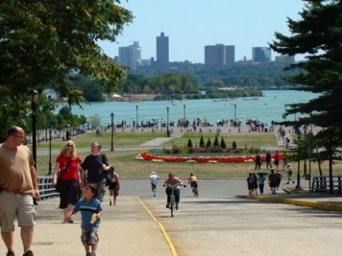 Building eventually became the temporary home of the U.N. General Assembly [1948 – 1952] and currently houses the Queens Museum. It was there that Palestine was partitioned and Israel created; and Korea partitioned and South Korea created.
Building eventually became the temporary home of the U.N. General Assembly [1948 – 1952] and currently houses the Queens Museum. It was there that Palestine was partitioned and Israel created; and Korea partitioned and South Korea created.
Flushing Meadow Park was created out of an ash pile for the people of New York to use as a recreational center. Two lakes would survive, as would most of the transportation infrastructure put in place by Robert Moses and NYC to accommodate the housing and transportation of the influx of visitors.
And the Meadow Lake Boathouse survived, which every summer is the location of the largest single tourist attraction in Queens: the Hong Kong Dragon Boat Festival.
1939 – 1940 World’s Fair – Invisible Legacies
Perhaps the greatest legacy of the 1939 – 1940 World’s Fair was the multi-culturalism, multi-nationalism that was exemplified at the fair, in spite of the beginning of a world 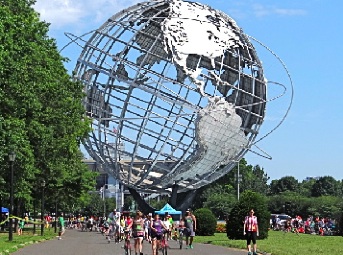 war. People from 60 nations co-habited a spot on the planet, while their nations were at war, and didn’t set off to fighting themselves. Queens continues to exemplify that legacy, as about half of the population of Queens was born elsewhere and over 100 languages are spoken in the borough.
war. People from 60 nations co-habited a spot on the planet, while their nations were at war, and didn’t set off to fighting themselves. Queens continues to exemplify that legacy, as about half of the population of Queens was born elsewhere and over 100 languages are spoken in the borough.
The Unisphere is the physical representation of many peoples and one world, but it was created by U.S. Steel for the 1964 NYC World's Fair - not the 1939 NYC World's Fair. That said the Unisphere, which measures 120 feet in diameter, harks back to one of the two main symbols of the 1939 World's Fair - the Perisphere [a large sphere] which was 180 feet in diameter.
A second, emerging legacy, may be the use of science in helping create a better society. Last year NYC designated a technology center on Roosevelt Island.
Flushing Meadow Corona Park vis a vis Central Park
At one of the Community Board Meetings, one of the participants asked whether the park could be granted landmark status or some historic designation to protect it from future development. After learning about the history of Flushing Meadows Corona Park, Queens denizens must decide whether Flushing Meadows Corona Park is more than a park, but also a historial and cultural site. And if the park is of cultural significance, in what manner should government officials protect and / or develop it.
As a point of reference, Central Park was a mess in the 1930's and cleaned up by Robert Moses during the LaGuardia administration. Robert Moses envisioned that one day Flushing Meadows Corona Park could evolve to become a park rivaling - if not surpassing - Central Park. Central Park was designated a National Historic Landmark in 1962 and as far as I know, no new structures have been erected in the park since that designation. In fact in 2012 a gift of $100 million was given for preservation and care of the park.
Stay tuned for our next report about the Battle for the Heart of a Park and the Soul of a Borough which we'll post Monday, January 14th, 2013. The Part II report is entitled NYC Stadiums: Battle of the Titans.
Appreciation & Thanks - 1939 - 1940 World's Fair NYC
We acknowledge the informational and photo contributions of the following: The Museum of the City of New York [Worlds Fairs Exhibit 2012 – 2013], the Queens Museum of Art [1939 Worlds Fair exhibit 2011], Macaulay Cuny, Wikipedia, Google maps and NYC Parks Department.
Photos - 1939 - 1940 World's Fair - Flushing Meadow Corona Park
The following is a slide show of photos taken of the 1939 - 1940 World's Fair in Flushing Meadow Corona Park, as well as some early photos of the Corona Ash Dump and Flushing Meadow Park. Use the arrow keys to move through it at your own pace or click this link to view photos of the 1939 - 1940 NYC World's Fair in Flushing Meadow Corona Park in Queens.
$element(ophoto,photo_slideshow,222,660,,5.00,fade)$
Jackson Heights / Elmhurst Related Info
Click these links for promotions, discounts and coupons in Jackson Heights, Corona and Queens.
Click this link to go to the Jackson Heights & Elmhurst Neighborhood News / Jackson Heights Restaurants / Jackson Heights & Elmhurst Shopping.
Site Search Tips. 1) For best results, when typing in more than one word, use quotation marks - eg "Astoria Park". 2) Also try either singular or plural words when searching for a specific item such as "gym" or "gyms".
$element(bwcore,insert_search,N)$
Click this link to search for something in our Queens Business Directory.
$element(adman,groupad,Sectional2 Ad)$
Click the log in link below to create an ID and post an opinion.
Or send this story to a friend by filling in the appropriate box below.
1964 Worlds Fair - NYC World's Fair 1964 - 1965
1964 worlds fair 1965 nyc worlds fair nyc worlds fairs flushing queens
Battle for the Heart of a Park …
 ... and the Soul of a Borough
... and the Soul of a Borough
The NYC World's Fair: 1964 - 1965 in Flushing Queens
PART II - NYC Stadiums: Battle of the Titans
January 21, 2013 / Queens Neighborhoods / Queens Issues / Queens Buzz. Click here for Part I of our report series on Developments in Flushing Meadows Corona Park where we journeyed back to the Corona Ash Dump, immortalized in the Great Gatsby, and later transformed into a World’s Fair utopia by Robert Moses, Fiorello LaGuardia and the 1939 World’s Fair committee.
The 1939 World’s Fair attracted over 40 million people, but lost over $100 million, as it opened the year Nazi Germany beganinvading its European neighbors, and while Japan was busy invading China. Nonetheless, in spite of a financial failure for the 1939 World’s Fair bondholders, the fair had enabled NYC and Robert Moses to complete phase one of his vision to transform the Corona Ash Dump into NYC’s premier city park, and build a whole new network of highways around it.
Ebbets Field in Brooklyn & The Brooklyn Dodgers
We resume our story, after WWII, as a young lawyer in Brooklyn  began working for the Brooklyn Dodgers. The Dodgers played at Ebbets Field just east of Prospect Park in what is the now Crown Heights neighborhood of Brooklyn. The year is 1943 as a 40 year-old lawyer, Walter O’Malley, leaves the Brooklyn Trust Company where he had oversight responsibilities for troubled companies, including the Brooklyn Dodgers.
began working for the Brooklyn Dodgers. The Dodgers played at Ebbets Field just east of Prospect Park in what is the now Crown Heights neighborhood of Brooklyn. The year is 1943 as a 40 year-old lawyer, Walter O’Malley, leaves the Brooklyn Trust Company where he had oversight responsibilities for troubled companies, including the Brooklyn Dodgers.
You can click here later today to read Part II of our report on proposed developments in Flushing Meadows Corona Park entitled NYC Stadiums: Battle of the Titans. Or click this link in the meantime to view Part I of our report series entitled - Out of the Ashes Rises the Phoenix - about the beginnings of Flushing Meadows Corona Park and the 1939 World's Fair.
Battle for the Heart of a Park …
... and the Soul of a Borough
The NYC World's Fair: 1964 - 1965 in Flushing Queens
PART II - NYC Stadiums: Battle of the Titans
DRAFT - PHOTOS COMING SOON
 January 21, 2013 / Queens Neighborhoods / Queens Issues / Queens Buzz. Continued. Bear in mind, that this reportorial series is being published while a number of large, well funded, private interests are working with city and state government officials to expand their acreage or square footage footprint in Flushing Meadows Corona Park; or in the case of one of the entities, to establish a new 13 acre footprint right in the heart of Flushing Meadows Corona Park. Two of the four proposals have been submitted by sports franchises that already have their own stadium(s) in Flushing Meadows Corona Park [the New York Mets & the United States Tennis Association (USTA)]. And a third entity, Major League Soccer (MLS), has submitted a proposal to erect a new stadium on the park grounds just east of the Unisphere.
January 21, 2013 / Queens Neighborhoods / Queens Issues / Queens Buzz. Continued. Bear in mind, that this reportorial series is being published while a number of large, well funded, private interests are working with city and state government officials to expand their acreage or square footage footprint in Flushing Meadows Corona Park; or in the case of one of the entities, to establish a new 13 acre footprint right in the heart of Flushing Meadows Corona Park. Two of the four proposals have been submitted by sports franchises that already have their own stadium(s) in Flushing Meadows Corona Park [the New York Mets & the United States Tennis Association (USTA)]. And a third entity, Major League Soccer (MLS), has submitted a proposal to erect a new stadium on the park grounds just east of the Unisphere.
Keeping these modern day sports franchises in mind [the Mets, the USTA and MLS], we travel back in time to 1940’s Brooklyn & Queens. And our two major players are NYC City Planner Robert Moses, and Walter O’Malley, the soon-to-be owner of the Brooklyn Dodgers.
Walter O’Malley & The Brooklyn Dodgers Circa the 1940’s
O’Malley became the Brooklyn Dodgers VP and General Counsel in 1943, replacing Wendell Willkie, a one time candidate for U.S. president whose health was failing. Within two years, O’Malley, Dodgers President Branch Rickey and John L. Smith control 75% of the Brooklyn Dodgers stock, having purchased it primarily from the estates of the former Dodgers owners Ed McKeever and Charles Ebbets.
In 1946 O’Malley begins making plans for a new ballpark either by renovation of Ebbets Field in Brooklyn, or for construction of a new stadium in Brooklyn. In 1950, O’Malley becomes majority stockholder and president of the Dodgers, after buying some of Branch Rickey’s stock.
Ebbets Field Brooklyn & The Brooklyn Dodgers
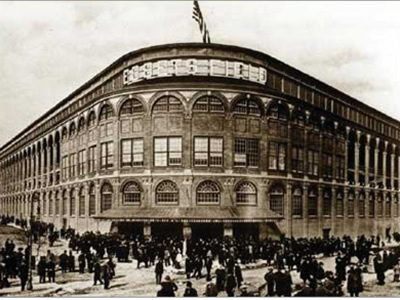 Ebbets Field was built in 1912 – 1913 by Charles Ebbets, the Dodgers owner who was also a trained architect. Ebbets Field had a seating capacity of 23,000 and parking for 700. By 1946 the stadium had become dated. And so for the next decade, O’Malley sought to find a new site upon which to build a new baseball stadium in Brooklyn.
Ebbets Field was built in 1912 – 1913 by Charles Ebbets, the Dodgers owner who was also a trained architect. Ebbets Field had a seating capacity of 23,000 and parking for 700. By 1946 the stadium had become dated. And so for the next decade, O’Malley sought to find a new site upon which to build a new baseball stadium in Brooklyn.
O’Malley began focusing his attention around the intersection of Flatbush and Atlantic Avenues in Brooklyn because this location was near NYC subways and a branch of the LIRR. O’Malley asked Robert Moses, NYC’s City Planner, for assistance in assembling the large plot of land so he could build a new stadium in Brooklyn. But Moses thought that Flushing Meadows Corona Park in Queens would make a better site for a new stadium.
Michael D’Antonio, Author of Forever Blue: The True Story of Walter O’Malley
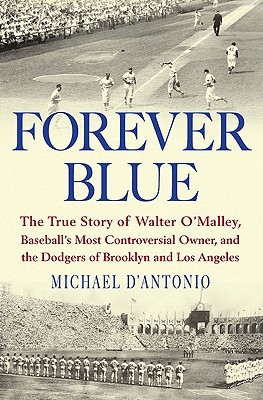 According to Michael D’Antonio, author of Forever Blue: The True Story of Walter O’Malley; Moses thwarted O’Malley’s effort to build a stadium in Brooklyn. O’Malley’s plans for a new stadium in Brooklyn centered around public transit access, which conflicted with Moses’ plans to develop the auto roadways around eastern Queens and Long Island. In an interview with the New York Times, D’Antonio characterized Moses as a “car guy”.
According to Michael D’Antonio, author of Forever Blue: The True Story of Walter O’Malley; Moses thwarted O’Malley’s effort to build a stadium in Brooklyn. O’Malley’s plans for a new stadium in Brooklyn centered around public transit access, which conflicted with Moses’ plans to develop the auto roadways around eastern Queens and Long Island. In an interview with the New York Times, D’Antonio characterized Moses as a “car guy”.
Moses tried to sell O’Malley on the idea of building a stadium in Flushing Meadow Park [as it was then called]. After efforts by both men to negotiate terms of a deal, O’Malley accepted an offer from the city of Los Angeles, and departed with the Brooklyn Dodgers in 1957.
According to reports, in addition to disagreement over the site location, the two titans differed over how the deal would be structured. Moses had tried to negotiate continued NYC ownership of the land and revenue sharing with the city; while O’Malley wanted the Dodgers franchise to own the land, paying only taxes on the property as well as franchise profits [verifying]. Moses fought for what he thought was best for the city, while O’Malley fought for what he thought was best for the Dodgers [whose colors were primarily blue – hence the book title].
Jackie Robinson & The Brooklyn Dodgers Break The Color Line
Brooklyn never forgave O’Malley for moving the Dodgers to Brooklyn, which is the thesis of D’Antonio’s book: Forever Blue. According to D’Antonio, there are several reasons for the decades-long vilification of O’Malley by Brooklyn Dodger fans. D’Antonio claims that the Brooklyn Dodgers had, in some senses, become America’s team long before that moniker was used. Fans unusual loyalty to the Dodgers came in part from the Dodgers’ image as an underdog team having gone to the World Series several times and lost. And the team earned a reputation for its courage in breaking through the color line by being the first Major League Baseball franchise to hire an African American player. Brooklyn Dodgers President Branch Rickey hired Jackie Robinson in 1947.
Brooklyn Loses Its Trolley Cars & The Brooklyn Eagle
D’Antonio states that there were other, less tangible, reasons too. In 1948 Brooklyn’s trolley line was closed down. And in 1955, the year the Brooklyn Dodgers won their first World Series, Brooklyn’s daily newspaper, the Brooklyn Eagle, closed its doors. “White flight” to the Long Island suburbs had been underway since the end of WWII, where Dodger fans began watching baseball games in the comfort of their homes on TV. Hence, in spite of the Dodgers’ successes on the field – including their first World Series win - ticket sales were down versus prior years and versus far less successful ball clubs.
O’Malley believed that Ebbets Field, a stadium that seated 23,000 people with only 700 parking spots, compromised the future of the Brooklyn Dodgers franchise. He noted that the Boston team had moved to Milwaukee, Wisconsin; where that team had attendance of two million fans in the same season that the World Series winning Brooklyn Dodgers had an attendance of only one million fans in NYC.
Dodgers Win 1955 World Series & Move To Los Angeles
So two years after defeating the New York Yankees and winning their first World Series pennant, the Brooklyn Dodgers moved to Los Angeles and went on to win two more World Series pennants before the end of the 1960’s. Adding to the hurt, the other NYC National League team [the New York Giants], also quietly moved west to San Francisco that same year, leaving NYC with only one baseball franchise: the American League Yankees.
Sportswriters Detested 1957 Brooklyn Dodgers Move To LA
Most sportswriters of the day blamed O’Malley who was vilified for decades. Even to this day, some 50 plus years later, O’Malley is jeered in some parts of Brooklyn. But the D’Antonio book takes a revisionist look at history, and shifts some of the responsibility for the Dodgers move to LA, onto NYC City Planner Robert Moses. As stated previously, Moses wanted the Dodgers to move to Queens to a stadium he would build for them in exchange for a revenue / expense sharing agreement between the city and the Brooklyn Dodgers [parking & concessions, etc - checking].
Walter O’Malley: Evil Owner Or Baseball Visionary?
In 1957 St Louis was the western-most Major League Baseball team. O’Malley convinced the New York Giants National League team to move west with the Dodgers so that the two teams could continue their National League rivalry. The two moves done in tandem, would also make it such that Eastern and Midwestern teams – after making the long trek west to California – could play multiple games with the two franchises, hence making the long trip worthwhile.
While most sports writers of the day vilified Walter O’Malley for moving the Brooklyn Dodgers team to Los Angeles; today he’s seen as something of a sports franchise visionary. In addition to supporting Branch Rickey’s hiring of Jackie Robinson in 1947, O’Malley is credited with moving Major League Baseball west and south of St. Louis, thus making Major League Baseball a truly national sport. Since then, many national sports franchises have moved from one city to another in search of a better deal.
Robert Moses & William Shea: Flushing Municipal Stadium
 In 1958, one year after losing both National League Baseball franchises, NYC Mayor Robert Wagner asked lawyer William Shea to chair a committee to bring a National League Baseball team to NYC. After several overtures to existing teams and a request to the National League to create an expansion team; Shea and Branch Rickey [former president of the Brooklyn Dodgers] began organizing the formation of a third league.
In 1958, one year after losing both National League Baseball franchises, NYC Mayor Robert Wagner asked lawyer William Shea to chair a committee to bring a National League Baseball team to NYC. After several overtures to existing teams and a request to the National League to create an expansion team; Shea and Branch Rickey [former president of the Brooklyn Dodgers] began organizing the formation of a third league.
The National League Baseball capitulated and NYC became home to the NY Mets in 1962. The Mets began playing in NYC in April 1962 and in Shea Stadium in 1964. They continued to play in Shea Stadium until October 2008. In 2009 the Mets started playing at the new CitiField Stadium which was built next to Shea Stadium in Flushing Meadows Corona Park in Queens. The New York Jets National League Football team also played at Shea Stadium from 1964 – 1983, after which they moved their games to MetLife Stadium in East Rutherford, New Jersey.
Relative to this report series, it’s worth noting at this point, that there’s a modern day precedent for the co-habitation of two major league / national sports franchises sharing the same stadium in NYC. For 19 years – from 1964 to 1983 - the NY Mets and the NY Jets played their home games in Shea Stadium. The owners of the Mets have publicly expressed an interest in working with Major League Soccer [MLS] to help them make CitiField their home stadium. It’s also worth noting that MLS has sponsored several summer soccer matches which have been hosted at CitiField over the past few years.
The 1964 NYC World’s Fair & Shea Stadium
In 1959 NYC Mayor Robert Wagner met with a small group to discuss hosting another World’s Fair in NYC. They chose Robert Moses to preside over it, given his effectiveness as a city planner and his experience with the 1939 World’s Fair. Moses saw this as an opportunity to further enhance Flushing Meadow into a park rivaling Central Park in Manhattan. So in tandem with the building of Shea Stadium, he set about organizing the 1964 World’s Fair.
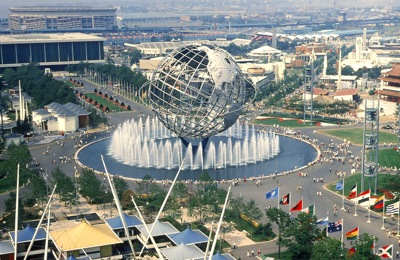
NY World's Fair 1964-1965 - Photo Compliments of ... PLC Jr on Flickr
"My Uncle Tony loved the World's Fair. Between my other uncles and him I easily went at least a dozen times over 1964 and 1965. The Unisphere was at the center of the Fair. He must have taken this from the observation towers of the New York State pavilion. In the background left is Shea Stadium with the El running in front of it. Pretty sure this was taken with his Leica."
http://www.flickr.com/photos/10946770@N04/1645715337 [cut & paste into browser]
1964 World's Fair - National / International Backdrop
In the 25 years since the 1939 World’s Fair, a World War had been fought, the atom had been split and used in bombs, televisions had proliferated throughout America, a cross country super highway system had been built, business systems / computers were coming of age, and outer space and deep sea exploration had begun.
After WWII ended, returning African American GI’s began asserting their civil rights as outlined in the Constitution and further supported by the 13th Amendment. They began demanding the same respect and treatment under the law given other ethnicities. Racial unrest became one of the most pressing issues of the time, and in July 1964, the Harlem riots spilled into the streets of New York City following the shooting of an African American youth by an off duty policeman.
Adding to these troubles, the 1964 World’s Fair was not endorsed by the BIE [Bureau of International Expositions], the official governing body of World’s Fairs, because no one nation was to host more than one World’s Fair within a ten year period. The U.S. had been designated the host of the 1962 World’s Fair in Seattle, Washington; and Montreal, Canada had been designated the host the 1967 World’s Fair. As a result, many of the 58 nations that had participated in the 1939 World’s Fair did not participate in the 1964 World’s Fair.
Hence both the absence of the BIE certification, and racial unrest in NYC, had a dampening effect on attendance of the 1964 Worlds Fair in a manner similar to the dampening impact on attendance that the impending Second World War had in 1939 - 1940.
1964 – 1965 NYC World’s Fair Statistics
The 1964 – 1965 World’s Fair attendance was projected to be 70 million versus the 40 million of the 1939 – 1940 World’s Fair. Like the previous World’s Fair, this one would fall far short of its forecast, as 26 million attended in 1964 and 25 million in 1965. It’s a bit unclear as to how much the fair cost, but NYC lost the $24 million it originally invested, and I believe bondholders and / or NYC lost about another $20 million by the time the dust settled. Tickets were $2 in 1964 and $2.50 in 1965.
1964 – 1965 NYC World’s Fair – More American / Less International
The internationalism of the 1939 – 1940 NYC World’s Fair was largely absent. And the science and new home gadgetry associated with the World of Tomorrow was now 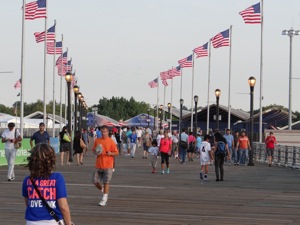 commonplace in many homes. The new technologies of the time, nuclear energy, space exploration and mainframe computers, were more applicable to government and industry, not consumers, and as such the 1964 World’s Fair didn’t have the ‘gee whiz’ factor characteristic of the 1939 NYC World’s Fair.
commonplace in many homes. The new technologies of the time, nuclear energy, space exploration and mainframe computers, were more applicable to government and industry, not consumers, and as such the 1964 World’s Fair didn’t have the ‘gee whiz’ factor characteristic of the 1939 NYC World’s Fair.
American pop culture made its way onto the 1964 World’s Fairgrounds with plays like Godspell, African American jazz and a Beatles concert was held nearby at Stadium in August of 1964. Shea Stadium was also the site of the 1964 MLB All Star Game which it will host again in 2013.
The Singer Bowl of the 1964 World’s Fair would later be named the Louis Armstrong Stadium, and eventually became home to the United States Tennis Association [USTA] in 1978.
1964 – 1965 World’s Fair Celebrates 300th Anniversary of NYC
 The 1964 NYC World’s Fair was designated to celebrate the 300th anniversary of the founding of New York City in 1664. To that effect, Robert Moses commissioned the creation of a miniature model of all five boroughs of New York City, which still stands to this day in a perpetual exhibit at the Queens Museum of Art.
The 1964 NYC World’s Fair was designated to celebrate the 300th anniversary of the founding of New York City in 1664. To that effect, Robert Moses commissioned the creation of a miniature model of all five boroughs of New York City, which still stands to this day in a perpetual exhibit at the Queens Museum of Art.
The NYC Watershed Relief Map had been built for the 1939 World’s Fair. This maps shows the topography and design of the NYC water system, including its portfolio of large reservoirs and aqueducts that provide the city its water using mostly gravity. Due to the impending war in 1939, government officials decided not to show the exhibit. But it was shown at the 1964 – 1965 NYC World’s Fair. The Watershed Relief Map, like the miniature map of NYC, is also on perpetual display at the Queens Museum of Art.
1964 NYC World’s Fair: Infrastructure & Legacies
Compared to the 1939 World’s Fair, there weren’t nearly as many infrastructure projects tied to the opening of the 1964 – 1965 NYC World’s Fair. Queens was no longer the open space it had been twenty-five years earlier; as the growing metropolis of NYC had expanded eastward using the infrastructure completed in preparation for the 1939 World’s Fair.
But that said there were a few infrastructure projects tied into the opening of the 1964 World’s Fair, included taking the northbound Flushing River underneath into tunnels. The Flushing River opened into Flushing Bay.
 The Flushing Bay waterfront along the northern rim of Corona was also developed into a harbor where some 600 [check] boats were able to dock. A waterfront administration building was built along with a number of tented standalones. The standalones were torn down after the 1965 NYC World’s Fair, but the World’s Fair Marina Administration Building was converted into a catered event hall.
The Flushing Bay waterfront along the northern rim of Corona was also developed into a harbor where some 600 [check] boats were able to dock. A waterfront administration building was built along with a number of tented standalones. The standalones were torn down after the 1965 NYC World’s Fair, but the World’s Fair Marina Administration Building was converted into a catered event hall.
A stretch of the Van Wyck Expressway was also completed, and some renovations and additions to LGA and JFK Airports were also completed. But I don’t know whether the airport upgrades were directly tied to the 1964 NYC World’s Fair effort.
1964 - 1965 World's Fair in NYC Exhibits
The large American Corporations that had participated in the 1939 World’s Fair returned to participate in the 1964 World’s Fair. This time, however, they didn’t have the kind of break through visions or consumer gadgetry announcements to make that they had in the late 1930’s.
In the 1950’s the Eisenhower Administration built the super highway system envisioned in the General Motors Futurama exhibit at the 1939 World’s Fair. The first public television broadcast of the 1939 World’s Fair was now commonplace, as TV sets had been purchased by a majority of American households [check]. Robots, first introduced in 1939, hadn’t really evolved much. And while IBM computers had evolved, in the early 1960’s they were still used largely by large corporations and government for scientific / complex calculations, or in corporate back offices for data processing.
The exciting science of the early 1960’s centered around space and sea exploration. The U.S. Space Agency hosted a two-acre exhibit including a rocket and engines. What remains of this exhibit is now shown at the NY Hall of Science on the western perimeter of Flushing Meadow Corona Park. The 1964 World’s Fair also built a heliport, which is today Terrace on the Park, a restaurant / catering facility for all sorts of events, and also located on the western perimeter of Flushing Meadows Corona Park.
U.S. Steel Corporation built the Unisphere to celebrate the World’s Fair theme of “Peace Through Understanding” dedicated to “Man’s achievement on a shrinking globe in an expanding universe”. The theme can still be found on a plaque near the globe.
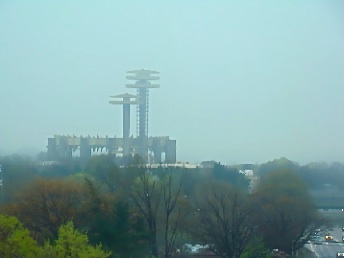 And the famous architect, Philip Johnson, built the New York Pavilion, a circular tented structure that still stands today – likely because he became a world renowned architect and it was subsequently added to the National Register of Historic Places. The pavilion stands next to the Queens Theatre in the Park. The nearby Observation Towers [closed] had been observation decks for the World’s Fair. The 1964 World’s Fair had an elevated train that circled the park through which passengers could view the grounds.
And the famous architect, Philip Johnson, built the New York Pavilion, a circular tented structure that still stands today – likely because he became a world renowned architect and it was subsequently added to the National Register of Historic Places. The pavilion stands next to the Queens Theatre in the Park. The nearby Observation Towers [closed] had been observation decks for the World’s Fair. The 1964 World’s Fair had an elevated train that circled the park through which passengers could view the grounds.
Disney became a major player at the 1964 World’s Fair, which became a prelude to their amusement parks. They set up five exhibits for other companies using some of their technology and characters. There was talk, at the end of the fair, of Disney establishing a theme park in Flushing Meadow Corona Park, but it never went beyond talk. Disney erected Disneyland in Orlando, Florida in 1967 and Disney World in Anaheim, California in 1972 [Check dates].
1964 – 1965 NYC World’s Fair – Park Legacies
The large infrastructure projects, like taking the Flushing River underground, completion of the Van Wyck Expressway, and the creation and enhancement of the Flushing Bay harbor continue to this day.
Following the 1964 – 1965 NYC World’s Fair close, many of the structures were kept intact by the NYC Parks Department. And many of the expensive exhibits created by corporations were also preserved, but shipped off to other destinations.
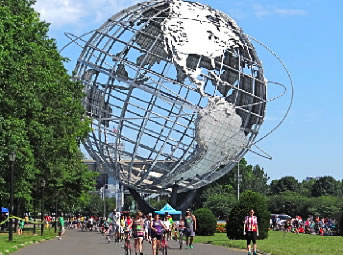 Today, the Unisphere remains at the center of the park. Shea Stadium remained up until its replacement by CitiField in 2008. Queens Theatre in the Park, the Observation Towers [closed to the public] and the Philip Johnson’s NY Pavilion [closed] all continue to stand to this day. Queens Theatre in the Park completed a major renovation in 2010. The NY Hall of Science is what remains of the U.S. Space exhibit. And the 1964 – 1965 NYC World’s Fair heliport is now Terrace on the Park. The World’s Fair Marina Administration Building is now the World’s Fair Marina building, an event hall and catering facility. Also, many of the harbor walkways and some of the harbor facilities also remain intact. There’s also a second structure [rest rooms] on Meadow Lake, which was built for the 1964 – 1965 World’s Fair, and continues to stand to this day. And the Singer Bowl stadium is now a part of the USTA complex.
Today, the Unisphere remains at the center of the park. Shea Stadium remained up until its replacement by CitiField in 2008. Queens Theatre in the Park, the Observation Towers [closed to the public] and the Philip Johnson’s NY Pavilion [closed] all continue to stand to this day. Queens Theatre in the Park completed a major renovation in 2010. The NY Hall of Science is what remains of the U.S. Space exhibit. And the 1964 – 1965 NYC World’s Fair heliport is now Terrace on the Park. The World’s Fair Marina Administration Building is now the World’s Fair Marina building, an event hall and catering facility. Also, many of the harbor walkways and some of the harbor facilities also remain intact. There’s also a second structure [rest rooms] on Meadow Lake, which was built for the 1964 – 1965 World’s Fair, and continues to stand to this day. And the Singer Bowl stadium is now a part of the USTA complex.
1964 – 1965 World’s Fair – Intangible Legacies
It’s more difficult to evaluate the 1964 World’s Fair impact on American and NYC culture, in part because it’s closer in and a part of the modern era in which we still live. But also perhaps because the changes of the early 1960’s were more cultural and less tangible.
In a manner similar to the 1939 World’s Fair, which came just before world turbulence [WWII], the 1964 World’s Fair came just before great national turbulence [race riots]. African Americans and women asserting their ethnic and gender rights [respectively] following the 1964 – 1965 NYC World’s Fair, and the educated and cynical youth of America decided they didn’t want to fight in other nations’ wars.
If the 1939 World’s Fair was about science & technology and internationalism and an impending war. The 1964 World’s Fair was perhaps the last major event where unbridled American optimism talked about in the Great Gatsby was on display. The emergence of pop and street culture, the re-emergence of battles for gender and ethnic equality, and a public struggle between the people and government officials over with a war the majority of Americans didn’t want to fight laid the ground for a changed America.
NYC Stadiums: Battle of the Titans - Lessons
There are a few lessons we can take away from this segment of our report series, and use them to help us better understand what kind of deal, we the public, are getting in some of the proposed developments for Flushing Meadows Corona Park.
When It Comes To Stadiums Size Matters. If a 23,000 seat stadium was inadequate for a ballpark in the 1950’s, how long will a 25,000 seat stadium be good for soccer in the second decade of the 21st century? In upgrades and expansions, where will the land come from?
 Major League Soccer attendance already averages 19,000 per game versus 30,000 per game for Major League Baseball [CitiField has seating capacity for over 40,000]; and MLS attendance was up almost 1,000 per game making it the fastest growing major league sport in the nation. But National Football is still by far and away the king with an average attendance of 67,000 people per game. The Meadowlands Stadium has seating capacity in excess of 80,000.
Major League Soccer attendance already averages 19,000 per game versus 30,000 per game for Major League Baseball [CitiField has seating capacity for over 40,000]; and MLS attendance was up almost 1,000 per game making it the fastest growing major league sport in the nation. But National Football is still by far and away the king with an average attendance of 67,000 people per game. The Meadowlands Stadium has seating capacity in excess of 80,000.
Why Can't CitiField Be Used By Both Major League Sports Franchises? As you can see in the photo to your left, Ecuador and Columbia played professional soccer match at CitiField on August 15, 2012. This event was organized by MLS. Why is it necessary to build a new stadium on 13 acres of public land in the heart of the borough's biggest, and easily one of its greatest parks, for a second stadium? As history has shown, the Jets and the Mets peacefully co-existed using Shea Stadium for 19 years.
Recent history has shown that park space in Queens is a valuable commodity. For example, it took the Jackson Heights Green Alliance and the Jackson Heights Beautification Groups two years [with a lot of effort by local government officials and a wealthy private organization] to acquire a 25,000 square foot plot [about one half acre] from the Garden School in Jackson Heights. The deal still isn't done and in the end the land will be shared between the privately held Garden School and the general public.
Public Transit Capacity & Queens Government Officials. The #7 subway line is believed to have had 209 million riders in 2010 [cumulative fares by stations], making it the single busiest line in NYC [and only five other routes are busier & they accommodate multiple subway lines - eg. North / South eastside NYC with the #4, #5 & #6 subway lines]. It's worth noting that the #7 subway line is also one of the faster growing subway lines in NYC. In January 2013 numerous Queens government officials protested the MTA’s methods of scheduling much needed maintenance and repair work on the #7 subway line.
Robert Moses generally included the costs of NYC transit infrastructure in his proposals. The government officials and denizens of Queens must ask what kinds of strains will these new developments in Flushing Meadows Corona Park put on NYC’s busiest subway line [the #7], and are upgrades for public transit and highways – if required – being factored into the public cost and quality of life tradeoffs implicit in these proposals?
For example, how much more traffic would a 20 game season [half the games played at home] at a 25,000 seat stadium, bring to Queens existing subways and roads; and how fast will the new traffic demands grow? How much traffic will a new shopping complex in the CitiField parking lot add to the #7 subway line, the Grand Central Parkway, and the Van Wyck and Long Island Expressways?
Expansion / New Stadium Deal Structure. Another question Queens denizens must ask themselves is how the deals for these expansions / new stadium will be structured. Robert Moses, representing NYC, and Walter O'Malley, representing the Brooklyn Dodgers, disagreed on the deal structure for a new stadium in the 1950's. Moses wanted to retain ownership of the land and share in the cashflow, while O'Malley wanted to own the land outright or secure a very long term lease. In structuring these deals, what valuation have government officials given to the 13 acres of land in the heart of one of the city’s - and perhaps world's greatest parks - versus whatever land will be given in exchange?
Other Options: More Jobs & Better Return On Investment. Is this what developing FMCP parkland is all about? Are other alternatives being considered for placing a sports facility on 13 acres of parkland in one of the greatest cities and the media capital of the world? For example, is there some other proposal of a similar nature – like a football stadium – that could provide a greater return on investment to Queens and the city. Naturally this assumes that Queens government officials and citizens believe that the public interest is best served by trading what proposal opponents believe to be the quality of life [open space / park land], for higher government tax revenue and jobs.
Part III - Proposed Developments in Flushing Meadows Corona Park
 In 1969, after only eight seasons, the Amazing Mets became the first expansion team to win a division title, a pennant and a World Series. They won the World Series in five thrilling games that many baseball fans still vividly remember. The Amazin’ Mets 1969 World Series was used as the backdrop for a scifi thriller movie in the late 1990’s entitled Frequency. And the last three games were played at Shea Stadium.
In 1969, after only eight seasons, the Amazing Mets became the first expansion team to win a division title, a pennant and a World Series. They won the World Series in five thrilling games that many baseball fans still vividly remember. The Amazin’ Mets 1969 World Series was used as the backdrop for a scifi thriller movie in the late 1990’s entitled Frequency. And the last three games were played at Shea Stadium.
By this time the power of Robert Moses - the city planner who moved mountains of ashes to create Flushing Meadows Corona Park - was in decline. But Robert Moses dream for Flushing Meadow Corona Park, still lives on. In Part III of this series we will continue our exploration of the four development proposals currently being evaluated by NYC and NYS government officials for Flushing Meadow Corona Park.
Click here to read Part I entitled Out of the Ashes Rises a Phoenix. And in the coming days or week, we'll post Part III of our series exploring the four proposed developments in Flushing Meadows Corona Park.
Thanks & Appreciation
Thanks to the Queens Museum of Art for providing access to their exhibits of the 1964 – 1965 World’s Fair materials. Also to the heirs of Walter O’Malley who run the website walteromalley.com. Other sources include Forever Blue: The True Story of Walter O’Malley by Michael D’Antonio and The Power Broker by Robert Caro. We also used both Wikipedia and nywf1964.com to reference some of the facts and statistics contained in this report, some of which we cross referenced with a number of other sites.
Flushing / Corona Related Info
Click these links for promotions, discounts and coupons in Flushing, Corona and Queens.
Click this link to go to the Flushing & Corona Neighborhood News / Flushing & Corona Restaurants / Flushing & Corona Shopping.
Site Search Tips. 1) For best results, when typing in more than one word, use quotation marks - eg "Astoria Park". 2) Also try either singular or plural words when searching for a specific item such as "gym" or "gyms".
$element(bwcore,insert_search,N)$
Click this link to search for something in our Queens Business Directory.
Site Search Tips. 1) For best results, when typing in more than one word, use quotation marks - eg "Astoria Park". 2) Also try either singular or plural words when searching for a specific item such as "gym" or "gyms".
$element(bwcore,insert_search,N)$
Click this link to search for something in our Queens Business Directory.
$element(adman,groupad,Sectional2 Ad)$
Click the log in link below to create an ID and post an opinion.
Or send this story to a friend by filling in the appropriate box below.
New York State Pavilion - Photos & Opening
The New York State Pavilion Opens For 3 Hours
Philip Johnson's 1964 World's Fair Relic Comes Back To Life
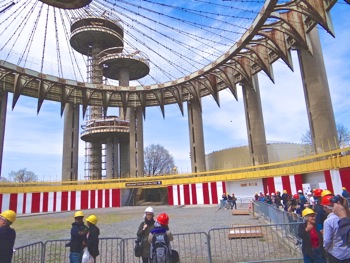 April 22, 2014 / Flushing Neighborhood / Queens History / Queens Buzz. The New York State Pavilion was reopened for three hours in commemoration of the 50th anniversary of the 1964 - 1965 World's Fair ... and thousands came to see it. An announcement that the structure was named to the National Trust For Historic Preservation was made at the opening.
April 22, 2014 / Flushing Neighborhood / Queens History / Queens Buzz. The New York State Pavilion was reopened for three hours in commemoration of the 50th anniversary of the 1964 - 1965 World's Fair ... and thousands came to see it. An announcement that the structure was named to the National Trust For Historic Preservation was made at the opening.
I had an opportunity to view the NYS Pavilion during the three hours it was open on April 22nd 2014. As mentioned above, the date marked the 50th anniversary of the opening of the 1964 - 1965 World's Fair. The NY State Pavilion was a structure commissioned for the Fair, which was held in Flushing Meadows Corona Park. The New York State Pavilion was built to honor and celebrate all things of New York State.
The complex encompasses three categorical elements: 1) the three observation decks shown in the background of the photo, 2) the Tent of Tomorrow - the inside from which this photo was taken, and 3) the Theaterama, which is shown in the background on the right. The Theaterama had been converted into Queens Theatre In The Park some time ago, and was renovated in 2008.
Interest in the NYS Pavilion began with a pilot project by the NYC Parks Department in 2007. The project was intended to explore its restoration / restore some of it [urban archeology]. And in 2009 a couple of guys decided they wanted to bring it back to life by [re]painting it. Since then, interest in the NYS Pavilion has been gradually gathering steam. Most recently a film maker crowd sourced funding to make a movie about it. And today it was named into the National Trust For Historic Preservation.
Click here for the story about the NYS Pavilion, including many details and a slide show containing photos of the New York State Pavilion.
The New York State Pavilion Opens For 3 Hours
Philip Johnson's 1964 World's Fair Relic Comes Back To Life
 April 22, 2014 / Flushing Neighborhood / Queens History / Queens Buzz. Continued. One could not have asked for a better day to briefly open the NYS Pavilion. It was sunny with highs around the 60's & 70's as the New York State Pavilion was opened to the public from 11 am to 2 pm.
April 22, 2014 / Flushing Neighborhood / Queens History / Queens Buzz. Continued. One could not have asked for a better day to briefly open the NYS Pavilion. It was sunny with highs around the 60's & 70's as the New York State Pavilion was opened to the public from 11 am to 2 pm.
I arrived a bit after noon, and the line to get in was backed up from within the center of Flushing Meadows Corona Park back out to 111th Street to the west. It was estimated that about a thousand people had gone through the structure within the first hour and based on my measure of the line, there were likely a couple thousand more waiting to get inside.
The NYC Parks Department provided hard hats along with hair nets, which one had to wear prior to going inside. The structure is now 50 years old, and very little maintenance work has been done to it, so the hard hats were precautionary in the events some paint or stone came loose.
The NYC Parks Department had done a nice job of curating the event, by posting signs along the wall providing a brief bit of history about the structure and its purpose. We photographed those signs which included historic photos and they are included in the slide show below.
The parks personnel also seemed to have been well briefed, as those I spoke to seemed pretty knowledgeable about the structure. Renowned architect, Philip Johnson, of the famous glass house up in New Caanan Connecticut.
THIS IS A WORK IN PROGRESS. THANKS FOR YOUR PATIENCE.
The Queens Theatre In The Park had been renovated during the Marshall Administration in 2008, and the recently renovated Queens Museum of Art was completed in 2013.
The New York State Pavilion Photos & Slide Show
Click here to view the NYS Pavilion photos.
$element(ophoto,photo_slideshow,258,660,,5.00,fade)$
Flushing / Corona Related Info
Click here to go to the Art Exhibits, Galleries & Museums section of this site.
Click these links for promotions by advertisers in Queens.
Click this link to go to the Flushing Neighborhood.
Site Search Tips. 1) For best results, when typing in more than one word, use quotation marks - eg "Astoria Park". 2) Also try either singular or plural words when searching for a specific item such as "gym" or "gyms".
$element(bwcore,insert_search,N)$
Click this link to search for something in our Queens Business Directory.
$element(adman,groupads,Sectional Ad)$
Click the log in link below to create an ID and post an opinion.
Or send this story to a friend by filling in the appropriate box below.
Flushing Meadows Corona Park - History & Development
Jul 19, 2013 at 04:26 pm by mikewood














